- Home
- G. K. Chesterton
The Man Who Was Thursday (Penguin ed) Page 3
The Man Who Was Thursday (Penguin ed) Read online
Page 3
If Chesterton’s protagonist, who himself experiences a form of ambulatory automatism as he roams about the suburbs of London at night, can be seen as a mad traveller, then he too is finally made to remember that he has forgotten who he really is. The name Thursday is, in this respect, not simply the pseudonym that he must adopt, when, as he falls into the depths of the nightmare, he is forced to assume the identity of an anarchist. It is his real name. It is the magic formula that, as in an incantation, brings his real identity into being. When Syme is forced to dress ‘as Thursday’ for the final biblical masquerade, at the end of the penultimate chapter, he experiences it as a relief, for ‘though he affected to despise the mummey, he felt a curious freedom and naturalness in his movements as the blue and gold garment fell about him’ (150). And his co-conspirators, from Monday through to Saturday, undergo the same epiphany, since ‘these disguises did not disguise, but reveal’ (150). As Slavoj Žižek has remarked of this passage, ‘it is no longer “If you want to show your true self, tear off the mask!”, but, on the contrary, “If you want to show your true self, put on the right mask!”.’33 In becoming Thursday, he becomes himself; and it is the consciousness that he is secretly Thursday that makes Syme feel he is ‘in possession of some impossible good news’ when he resurfaces from the nightmare on a country lane at first light. In the terms provided by Orthodoxy, he is residually conscious of the fact that, for one awful instant, he remembered that he had forgotten who he is; and this is in itself enough to transfigure his everyday life. The deeper irony of the novel’s title, then, is that this man is indeed Thursday. It is not simply some disguise that he temporarily assumed; it is the originary identity that he has managed to dig up. He is most himself when he finally becomes the man he pretended to be.
So The Man Who Was Thursday is framed in the form of an episode of mad travelling, a feverish tramp through the night in which Syme adopts the false identity that is in fact his true identity. The scene of his epiphany – though the reader is made to forget this until the final paragraphs of the book – is the road along which he has been walking through the night. For Chesterton, as the narrative frame emphasizes, the street is the supreme repository of poetry. ‘Let us go through certain half-deserted streets’, he appeals to his reader, like T. S. Eliot’s Prufrock. But Chesterton’s streets do not ‘follow like a tedious argument / Of insidious intent’; they twist and gyrate with a mysterious, sometimes grotesque sense of joy. They are not meaningless, but pregnant with spiritual significance. In one of the most sinister and darkly comic passages in The Man Who Was Thursday, when Chesterton’s urban fairy tale acquires a particularly demented force, Syme discovers to his horror that the ancient, death-like anarchist Professor de Worms, codenamed Friday, is stalking him through London’s ‘labyrinth of little streets’ (61). For, although the Professor appears to be decrepit, he displays an athletic capacity for keeping up with Syme that is deeply disturbing. However much Syme accelerates, however much he deliberately loses himself in the maze of alleys and lanes that lie off the main thoroughfares, he continues to hear ‘the clinking crutch and labouring feet of the infernal cripple’ as he stops to catch his breath (62). Finally, in a state of desperation that is almost ecstatic, Syme has ‘a new impulse to tear out the secret of this dancing, jumping and pursuing paralytic’ (63), and he determines to turn and confront his pursuer. When he does so, the professor’s form, outlined against a gas lamp, recalls ‘that very imaginative figure in the nursery rhymes, “the crooked man who went a crooked mile”.’ ‘He really looked,’ the narrator adds, ‘as if he had been twisted out of shape by the tortuous streets he had been threading.’ (63) The Professor comes closer and closer; and Syme, ‘remembering all the nightmares he had ever known’, simply waits for him, ‘as St George waited for the dragon, as a man waits for a final explanation or for death’…
It transpires, of course, that the Professor – his ‘pale, grave’ head grotesquely attached to a ‘bounding body’, ‘like the head of a lecturer on the body of a harlequin’ – is himself a heavily disguised police detective. The relief that the reader feels at this revelation, however, does not efface the indelible creepiness of the chase that Chesterton has so brilliantly described. The metropolitan city itself, after this episode, appears to be fatally haunted. On its streets, crisscrossed by both satanic and angelic energies, identities are ceaselessly made and unmade. Chesterton, the descendant of Dickens and Poe, is one of the great modernist poets of the city, even though he is generally classified neither as a modernist nor as a poet. His epiphanies take place on pavements. In The Napoleon of Notting Hill (1904), Chesterton’s first novel, he describes in some detail a volume of poems by one of his most representative fictional characters, the pathologically eccentric Adam Wayne. The poems themselves are supposedly rather poor, but they are nonetheless remarkable for channelling all the spiritual passion of Romanticism from the countryside into the city, and for positing London as the supreme poetic subject. This poet, apparently, in one of the finer poems to apostrophize his muse, ‘instead of saying that the rose and the lily contend in her complexion, says, with a purer modernism, that the red omnibus of Hammersmith and the white omnibus of Fulham fight there for the mastery!’34 The Man Who Was Thursday is itself an instance of this ‘purer modernism’, which jams the most incongruous urban images up against one another in order to evoke the glorious chaos of being in a metropolitan city. The spectacular opening sight of the anarchists in Chapter 5, boisterously eating breakfast on the balcony overlooking Leicester Square, is an exemplary instance of this, because it concentrates Syme’s ‘eerie sensation of having strayed into a new world’ (41). Chesterton’s metropolitan city is an unstable, even at times explosive compound of the exotic and the everyday. It is in the same spirit that, in the opening chapter of The Man Who Was Thursday, Syme insists that, in so far as it embodies a kind of rapturous desire for order, the London Underground is ‘the most poetical thing in the world’ (4). Chesterton’s modernism is a triumphant form of urban romanticism.
The narrator of The Napoleon of Notting Hill comments at one point that Adam Wayne ‘was perhaps the first to realise how often the boundary of fairyland runs through a crowded city’.35 He was of course far from the first to realize this. Chesterton was himself conscious that Dickens had been the poet laureate of the metropolitan city in the nineteenth century because he possessed, ‘in the most sacred and serious sense of the term, the key of the street’:
Few of us understand the street. Even when we step into it, we step into it doubtfully, as into a house or room of strangers. Few of us see through the shining riddle of the street, the strange folk that belong to the street only […]. Of the street at night many of us know even less. The street at night is a great house locked up. But Dickens had, if ever man had, the key of the street. His earth was the stones of the street; his stars were the lamps of the street; his hero was the man in the street.36
Chesterton too had the key to the street; and the proof of this is that, as he said of Dickens in the same book, ‘he saw all his streets in fantastic perspectives’.37 As The Man Who Was Thursday above all illustrates, Chesterton was supremely adept at defamiliarizing the mundane properties of the metropolitan city and making them seem miraculous. The image of the street lamp, to which he returned again and again in his fictional and non-fictional prose, is a good example of this, because it is an emblem of what, in Orthodoxy, Chesterton calls ‘practical romance’: it combines ‘something that is strange with something that is secure’, ‘an idea of wonder and an idea of welcome’. Like other ordinary objects that only need to be estranged for a moment to seem extraordinary, it answers a ‘double spiritual need, the need for that mixture of the familiar and the unfamiliar which Christendom has rightly named romance’.38
From its title on, The Man Who Was Thursday brings a fantastic perspective to bear on everyday life, and particularly the everyday life of the modern city. This fantastic perspective is of course informed by
Chesterton’s Christian faith, which became increasingly confident in the opening decade of the twentieth century, though he did not officially convert to Catholicism until 1922. I am however convinced that Hynes was right when, some time ago, he claimed that, in spite of the important scholarship on Chesterton by religious critics, ‘above all, he needs secular attention’.39 For Chesterton’s commitment to estranging and transfiguring the commonplace is in literary terms consonant with the contemporaneous reaction against nineteenth-century realism. The Man Who Was Thursday is an incomparable instance of what might be called modernist romance. It uses some of the emergent techniques of modernism in order not to disenchant but to re-enchant everyday life. It takes the man who ambles about the streets but cannot remember his name and, in a gesture as anarchic as it is ecstatic, it spins him about in order to recall him abruptly to himself. Suddenly, this man inhabits a Wonderland in which, though nothing makes sense, everything makes sense. So too, as a blaze of astonishment flares up at the back of the brain, does Chesterton’s reader.
NOTES
1. G. K. Chesterton, Autobiography (London: Hutchinson, 1936), p. 101.
2. Kingsley Amis, ‘Introduction’, The Man Who Was Thursday (Harmondsworth: Penguin, 1986), p. 4.
3. G. K. Chesterton, Orthodoxy (London: Bodley Head, 1908), pp. 80–81.
4. Chesterton, Orthodoxy, p. 132.
5. Oliver Sacks, The Man Who Mistook His Wife for a Hat (London: Picador, 1986), p. 9.
6. D. J. Conlon, ed., G. K. Chesterton: The Critical Judgments (Antwerp: Antwerp Studies in English Literature, 1976), p. 147.
7. Chesterton, Autobiography, pp. 101–2.
8. The Defendant (London: Dent, 1901), p. 69.
9. Conlon, ed., G. K. Chesterton, p. 145.
10. This is available at http://www.cse.dmu.ac.uk/~mward/gkc/380905.mp3
11. G. K. Chesterton, Charles Dickens (London: Methuen, 1906), p. 19.
12. Chesterton, Autobiography, p. 102.
13. Chesterton, Orthodoxy, p. 197.
14. Conlon, ed., G. K. Chesterton, p. 144.
15. G. K. Chesterton, The Innocence of Father Brown (Leipzig: Tauchnitz, 1911), p. 201.
16. G. K. Chesterton, Robert Browning (London: Macmillan, 1903), pp. 153, 111.
17. Chesterton, Charles Dickens, p. 213.
18. On ‘irrealist’ literature, see Michael Löwy, ‘The Current of Critical Irrealism: A Moonlit Enchanted Night’, in Adventures in Realism, ed. Matthew Beaumont (Oxford: Blackwell, 2007), pp. 193–206.
19. G. K. Chesterton, ‘Dreams’, in The Coloured Lands (London: Sheed & Ward, 1938), pp. 81–2.
20. Conlon, ed., G. K. Chesterton, p. 148.
21. Conlon, ed., G. K. Chesterton, p. 152.
22. Chesterton, Autobiography, p. 102.
23. Conlon, ed., G. K. Chesterton, p. 145. See also Heather Worthington, ‘Identifying Anarchy in G. K. Chesterton’s The Man Who Was Thursday’, in ‘To Hell with Culture’: Anarchism and Twentieth-Century British Literature, eds. H. Gustav Klaus and Stephen Knight (Cardiff: University of Wales Press, 2005), pp. 21–34.
24. See William Oddie, Chesterton and the Romance of Orthodoxy: The Making of GKC, 1874–1908 (Oxford: Oxford University Press, 2008), pp. 84–125.
25. G. K. Chesterton, ‘The Nightmare’, in Alarms and Discussions (London: Methuen, 1910), pp. 17, 20.
26. Chesterton, Autobiography, pp. 91–2.
27. Samuel Hynes, ‘The Chesterbelloc’, in Edwardian Occasions: Essays on English Writing in the Early Twentieth Century (London: Routledge & Kegan Paul, 1972), p. 83.
28. Chesterton, Autobiography, pp. 93–4.
29. Chesterton, Autobiography, pp. 94–5.
30. Chesterton, Autobiography, p. 95.
31. Chesterton, Orthodoxy, pp. 80–81.
32. See Ian Hacking, Mad Travellers: Reflections on the Reality of Transient Mental Illnesses (Cambridge, Mass.: Harvard University Press, 1998), p. 12.
33. See Slavoj Žižek, ‘Hegel – Chesterton: German Idealism and Christianity,’ in The Symptom (http://www.lacan.com/zizhegche.htm).
34. Gilbert K. Chesterton, The Napoleon of Notting Hill (London: Bodley Head, 1904), p. 129.
35. Chesterton, The Napoleon of Notting Hill, p. 131.
36. Chesterton, Charles Dickens, pp. 44–5.
37. Chesterton, Charles Dickens, p. 144.
38. Chesterton, Orthodoxy, pp. 3–4.
39. Hynes, ‘The Chesterbelloc’, p. 80.
Further Reading
EDITIONS OF THE MAN WHO WAS THURSDAY
The Collected Works of G. K. Chesterton, Vol. 6: The Man Who Was Thursday, The Club of Queer Trades, The Napoleon of Notting Hill, The Ball and the Cross, ed. Denis J. Conlon (San Francisco: Ignatius Press, 1991).
The Man Who Was Thursday and Related Pieces, ed. Stephen Medcalf (Oxford: World’s Classics, 1996).
The Annotated Thursday: G. K. Chesterton’s Masterpiece, The Man Who Was Thursday, ed. Martin Gardner (San Francisco: Ignatius Press, 1999).
EDITIONS OF G. K. CHESTERTON
The Collected Works of G. K. Chesterton (San Francisco: Ignatius Press, 1986).
STUDIES OF G. K. CHESTERTON
Ahlquist, Dale, G. K. Chesterton: The Apostle of Common Sense (San Francisco: Ignatius Press, 2003).
Barker, Dudley, G. K. Chesterton: A Biography (London: Constable, 1973).
Belloc, Hilaire, On the Place of Gilbert Chesterton in English Letters (London: Sheed & Ward, 1940).
Boyd, Ian, The Novels of G. K. Chesterton: A Study in Art and Propaganda (London: Elek, 1975).
Canovan, Margaret, G. K. Chesterton: A Radical Populist (New York: Harcourt Brace Jovanovich, 1977).
Caserio, Robert L., ‘G. K. Chesterton and the Terrorist God outside Modernism’, in Lynne Hapgood and Nancy L. Paxton, eds., Outside Modernism: In Pursuit of the English Novel, 1900–30 (Basingstoke: Macmillan, 2000: 63–82).
The Chesterton Review: A Newsletter of the G. K. Chesterton Society (1974–).
Clemens, Cyril, Chesterton as Seen by His Contemporaries (Webster Groves, Mo.: International Mark Twain Society, 1939).
Clipper, Lawrence J., G. K. Chesterton (New York: Twayne, 1974).
Coates, John D., Chesterton and the Edwardian Cultural Crisis (Hull: Hull University Press, 1984).
Coates, John, G. K. Chesterton as Controversialist, Essayist, Novelist and Critic (Lewiston, NY: E. Mellen Press, 2002).
Conlon, D. J., ed., G. K. Chesterton: The Critical Judgments (Antwerp: Antwerp Studies in English Literature, 1976).
Conlon, D. J., ed., G. K. Chesterton: A Half Century of Views (Oxford: Oxford University Press, 1987).
Coren, Michael, Gilbert: The Man Who Was G. K. Chesterton (London: Jonathan Cape, 1989).
Corrin, Jay P., Chesterton and Hilaire Belloc: The Battle against Modernity (Athens, Ohio: Ohio University Press, 1981).
Dale, Alzina Stone, The Outline of Sanity: A Biography of G. K. Chesterton (Grand Rapids, Mich.: Eerdmans, 1982).
Evans, Maurice, G. K. Chesterton (Cambridge: Cambridge University Press, 1939).
Finch, Michael, G. K. Chesterton (London: Harper Collins, 1986).
Hollis, Christopher, The Mind of Chesterton (London: Hollis & Carter, 1970).
Hunter, Lynette, G. K. Chesterton: Explorations in Allegory (London: Macmillan, 1979).
Hynes, Samuel, ‘The Chesterbelloc’, in Edwardian Occasions: Essays on English Writing in the Early Twentieth Century (London: Routledge & Kegan Paul, 1972: 80–90).
Kenner, Hugh, Paradox in Chesterton (London: Sheed & Ward, 1948).
Oddie, William, Chesterton and the Romance of Orthodoxy: The Making of GKC, 1874–1908 (Oxford: Oxford University Press, 2008).
Sullivan, John, ed., G. K. Chesterton: A Centenary Appraisal (London: Elek, 1974).
Sullivan, John, G. K. Chesterton: A Bibliography (London: University of London Press, 1958).
Ward, Maisie, Gilbert Keith Chesterton (New York: Sheed & Ward, 1943).
Ward, Maisie, Re
turn to Chesterton (London: Sheed & Ward, 1952).
Wills, Gary, Chesterton: Man and Mask (New York: Sheed & Ward, 1961).
Worthington, Heather, ‘Identifying Anarchy in G. K. Chesterton’s The Man Who Was Thursday’, in ‘To Hell with Culture’: Anarchism and Twentieth-Century British Literature, eds. H. Gustav Klaus and Stephen Knight (Cardiff: University of Wales Press, 2005: 21-34).
Žižek, Slavoj, ‘The “Thrilling Romance of Orthodoxy”’, in Theology and the Political: The New Debate, eds. Creston Davis, John Milbank and Slavoj Žižek (Durham, NC: Duke University Press, 2005: 52-71).
OTHER STUDIES
Batchelor, John, The Edwardian Novelists (London: Duckworth, 1982).
Butterworth, Alex, The World that Never Was: A True Story of Dreamers, Schemers, Anarchists and Secret Agents (London: Bodley Head, 2010).
Carey, John, The Intellectuals and the Masses: Pride and Prejudice among the Literary Intelligentsia, 1880-1939 (London: Faber & Faber, 1992).
Cole, Sarah, ‘Dynamite, Violence and Literary Culture’, Modernism / Modernity 16: 2 (2009): 301–28.
Freeman, Nicholas, Conceiving the City: London, Literature, and Art 1870-1914 (Oxford: Oxford University Press, 2007).

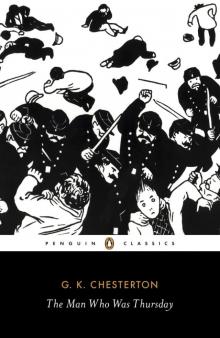 The Man Who Was Thursday: A Nightmare
The Man Who Was Thursday: A Nightmare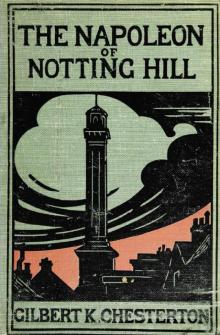 The Napoleon of Notting Hill
The Napoleon of Notting Hill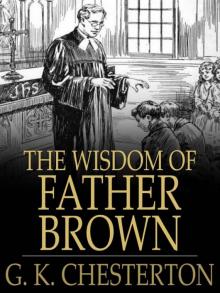 The Wisdom of Father Brown
The Wisdom of Father Brown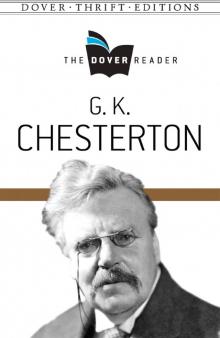 G K Chesterton- The Dover Reader
G K Chesterton- The Dover Reader The Essential G. K. Chesterton
The Essential G. K. Chesterton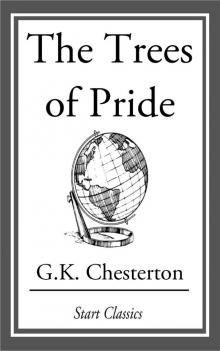 The Trees of Pride
The Trees of Pride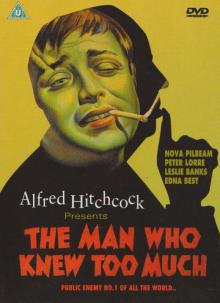 The Man Who Knew Too Much
The Man Who Knew Too Much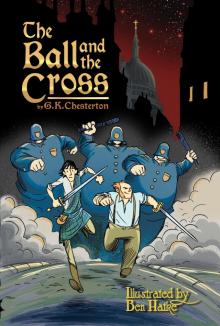 The Ball and the Cross
The Ball and the Cross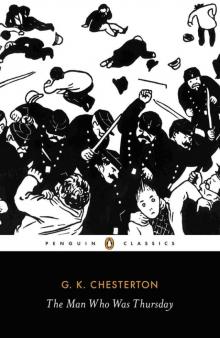 The Man Who Was Thursday (Penguin ed)
The Man Who Was Thursday (Penguin ed)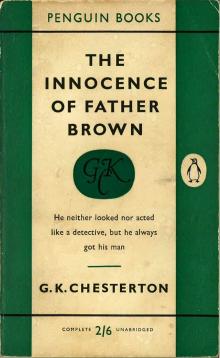 The Innocence of Father Brown
The Innocence of Father Brown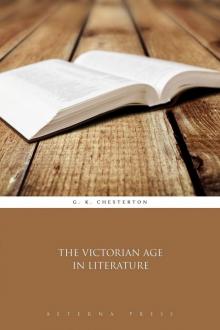 The Victorian Age in Literature
The Victorian Age in Literature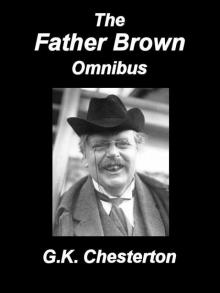 Father Brown Omnibus
Father Brown Omnibus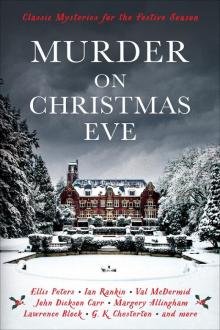 Murder On Christmas Eve
Murder On Christmas Eve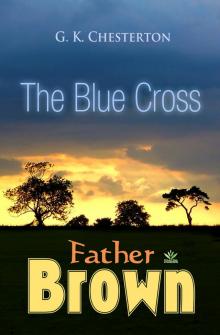 The Blue Cross
The Blue Cross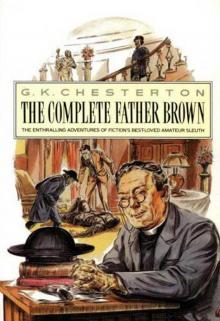 The Complete Father Brown Mysteries Collection
The Complete Father Brown Mysteries Collection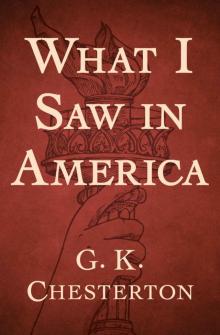 What I Saw in America
What I Saw in America